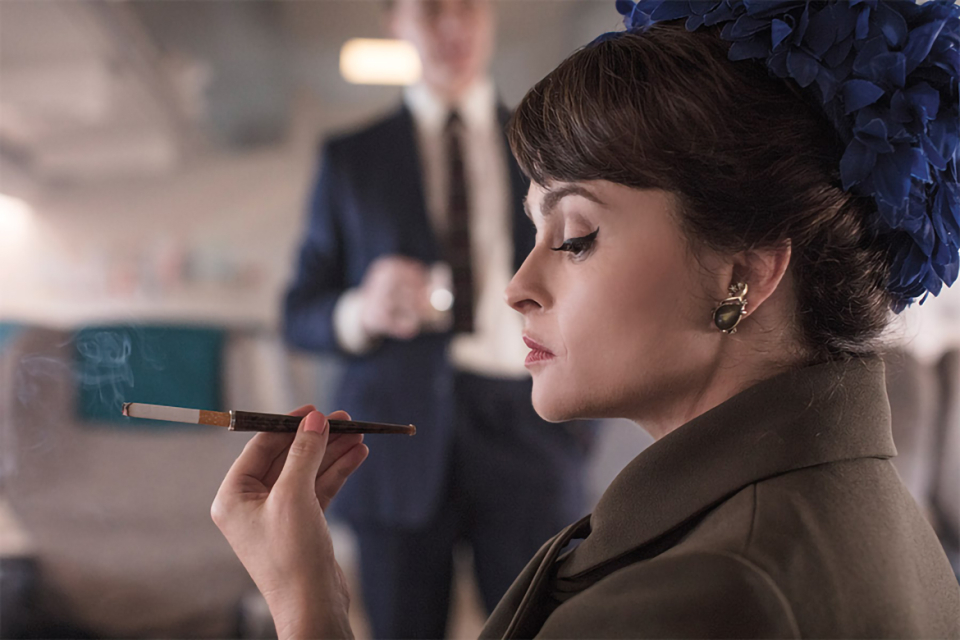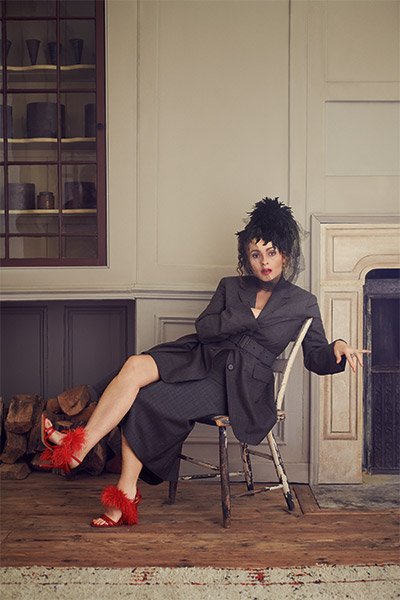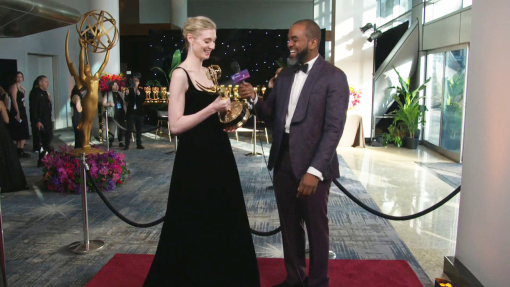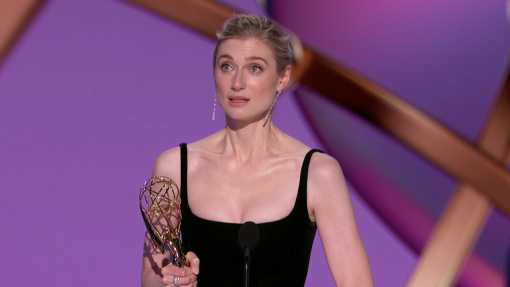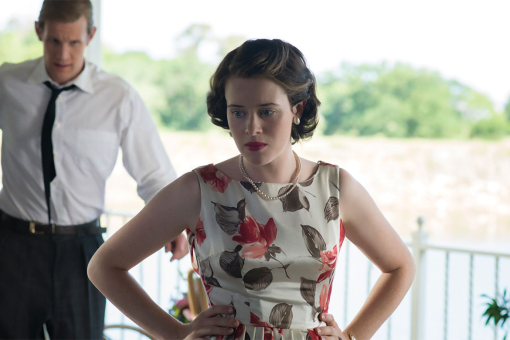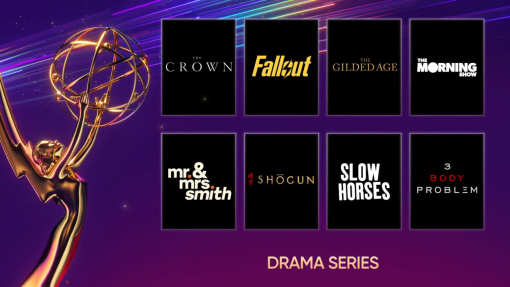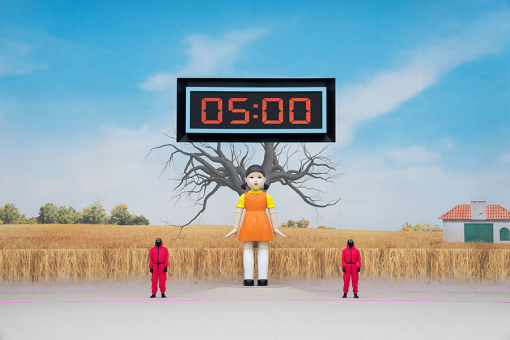Her very first day on set, Olivia Colman sat down at the queen's writing desk and saw a sheet of postage stamps. There, in profile, was her own face.
"That was just… cool," she says. "I got really overexcited. I thought, 'Quick! Send a picture to my husband.' All the stuff that I'm probably not allowed to have done, I totally did it."
The producers of The Crown probably wouldn't have minded much: Colman is their prime asset. In five years she's gone from being known best as a great supporting actress (in such series as Fleabag, Broadchurch and The Night Manager) to being known as simply the best.
She won the Best Actress Oscar for The Favourite this year, and when she succeeds Claire Foy as Elizabeth Windsor — better known as Queen Elizabeth II — for the third and fourth seasons of The Crown, her career coronation will be complete. Seeing her in the lead, it's hard to imagine how the producers could have thought of anyone else. In fact, they didn't.
"Olivia was not just our first choice, she was our first thought," says Andy Harries, one of the seven executive producers of The Crown, a coproduction of Left Bank Pictures and Sony Television for Netflix. (His fellow EPs are Peter Morgan, Suzanne Mackie, Stephen Daldry, Benjamin Caron, Matthew Byam Shaw and Robert Fox.)
"We rang up her agent and asked if she would like to meet Peter Morgan [also creator–writer] and me for a cup of tea. We went to the Beaumont Hotel in Mayfair, London, and as we arrived, she was already sitting at the table. As we sat down, she went, 'Yes! Yes! Yes!' so it wasn't that difficult, really. She's one of the greatest actors of our generation — there's no question about that."
It is typical of Colman that when she hears that story, she grins nervously and virtually ingests herself with embarrassment. "Ah, yes. I think I was meant to be cooler than I was. No one told me you're meant to go, 'I don't know…. I'll think about it.' I was like, 'Yes, please!' I'll know next time."
There will doubtless be many more "next times" involving plum roles dangled at swank hotels, because Colman is now at the head of acting's top table. But when she hears that, she replies, with regal self-effacement, that it just means she gets to work with the very best people.
"I mean, come on, take The Crown," she says, sipping a cup of tea. "Helena Bonham Carter is my sister!"
As if on cue, Bonham Carter enters the room and the pair of them air-kiss and giggle. They're on the ground floor of a four-story Georgian townhouse in London's Spitalfields district, and the lighting is so authentically Dickensian that they can barely see each other.
In fact, in the low light they really could pass for sisters. In season three, which debuts November 17, Bonham Carter succeeds Vanessa Kirby as Princess Margaret, and the sisters' relationship becomes more central.
"A lot happens with Margaret during this time," Colman says. "We know that they are desperately loyal to each other: they're the only ones who really know each other inside-out. They slept in the same room in the nursery, they took every lesson together…. They are there for each other. It's very difficult, because they also have roles they have to play; they have to know their place.
"So it's tricky as well, but ultimately it's a lovely relationship: they are sisters who have each others' backs."
Bonham Carter adds that she and Colman also needed one another's support, sometimes literally. "Because there are a lot of walking shots in this, and neither of us can walk in high heels."
"That," Colman says, "would be my advice to whoever is cast as the queen after me: learn to walk in high heels. Neither of us can do it. We're rubbish. All of my favorite scenes were when the queen is in her wellies."
Season three of The Crown begins in 1964, with the election of Harold Wilson, a committed socialist, as only the second Labour prime minister since the second world war.
Covering the moon landings, the unmasking of Sir Anthony Blunt as a Soviet spy, the Aberfan mining disaster of 1966 and the slow dissolution of Margaret's marriage to Lord Snowdon, the 10 episodes portray swinging London and cultural upheaval against an immovable, stoic institution: the Crown.
"It's this horrible clash," Colman says. "There are all these societal goings-on at the time, and yet this family [is] still laboring under ancient notions of how you must be strong and you don't share anything — you put on a brave face."
In real life the queen, against all expectations, got along splendidly with Wilson. "The other prime ministers up to this point had all been older," Colman explains. "Churchill was like a father or even a grandfather figure. The rest were all older men who were very polite to the queen.
"Wilson didn't seem to have any of that. Men and women were equal in his eyes. He talked to her like an equal; he would listen to her opinions — she is a very bright woman — and for her that was brilliant. That's why there was this wonderful friendship."
Wilson is played by Jason Watkins (A Very English Scandal), a British actor of whom Colman speaks in glowing terms, as she does all her costars. "He's brilliant, and Wilson and the queen got on famously well. When they were away at Balmoral [Castle in Scotland], where the PM gets invited for a less-official trip, there'd be peals of laughter from the room. They'd be giggling, and then drinks trollies would be brought in."
That's precisely the kind of peek behind the curtain that has made The Crown a worldwide hit.
Queen Elizabeth II has been the most famous woman in the world for more than 60 years. Several generations have grown up knowing what she looks like and what she represents, yet almost no one knows what goes on behind the palace doors. It is an alchemical combination of the epic and the domestic that makes The Crown the ultimate family saga.
Having established a winning cast for two seasons, The Crown has sent itself back to square one. Every major character has been recast for seasons three and four, something no series has done before. (The show's casting directors, Nina Gold, CSA, and Robert Sterne, CSA, won the Emmy for Outstanding Casting for a Drama Series for season one of The Crown and were also nominated for season two.)
"This is an extraordinary and bold experiment, which was part of Peter's original idea," Andy Harries says. "When we came to the end of season two and were thinking about how good some of the characters were, we thought seriously about whether we should change them. We decided that if we were going to change one or two leads, we had to change everybody."
The Crown is about the institution of the monarchy as much as it is about the monarch herself, which means it only works if the whole royal family is credibly portrayed. Colman's casting is crucial, obviously, but Tobias Menzies (Game of Thrones, Outlander), who takes over from Matt Smith as Prince Philip, is just as important.
"It's a curious mixture of instinct and technique," Menzies says. "Everyone knows what [the royals] sound like and how they look; there's so much footage of them. Also, the show has already been made for two seasons. I did speak briefly to Matt around the time I got the part. But you're making a piece of fiction, and we want to make the show our own.
"That can't be [based on] Matt. And then you just forget all that and try and remember your lines."
Colman spoke with Claire Foy (who won the Emmy in 2018 as Outstanding Lead Actress in a Drama Series for her role in The Crown), but more as a courtesy than as a request for guidance.
"She said, 'You'll love it, the crew are all so lovely.' And almost all of the crew has come back, so clearly it was a happy job…. I mean, it's not really the done thing as an actor to say, 'Let me give you a few pointers.' It's such an unusual thing to take over a part in a TV show anyway. Truth is, it's got to be a little bit of a gut thing."
It only takes a few seconds of Colman's opening scenes to see that she has not just been expertly cast, but that her instincts will make the role her own. She can express misery, torment and delight in the slightest grimace or smile. She is often as static as the face on the postage stamp, but it is always clear this is a mask she has to wear.
As for Margaret, one insouciant drag on a cigarette from a head-scarved Bonham Carter shows that the queen's sister has also been reimagined to perfection. Episode two, in particular, is truly hers — not because she amps up Margaret's behavior for her 1965 tour of America (in which a slew of U.S. fans who call themselves "Margaretologists" track her every move), but because she dials it down.
Where Colman's performance is all protocol and restraint, often shot over her shoulder to emphasize that unyielding silhouette, Bonham Carter's performance is bolder but always controlled — evidence that the two are sisters first and foremost.
"I was a mixture of excited, daunted and then mildly insulted with the amount of people who said, 'Oh, she's perfect casting,'" says Bonham Carter, who looks nothing like the real thing, apart from her diminutive stature. "There's not much of me, and there wasn't much of Margaret.
"She comes with a reputation, but the real gift of the part is she has so many colors. She's like a prism — she changes. That's exciting," Bonham Carter continues. "When he met me, Peter [Morgan] said, 'The thing with Margaret is she's so unpredictable, so changeable, that really you can play the same scene 10 different ways and it still would be valid.' That was the lure."
Colman, by contrast, looks eerily like the queen, especially after the show's costume, makeup and hairstyling teams have gone to work. (The costume team won the Emmy for period costumes for seasons one and two; the hairstylists were Emmy-nominated both seasons.)
"The first time I saw myself in the mirror with the wig I was… quite giggly," Colman says, giggling quietly. "There's only one woman with that hairdo. I looked in the mirror and thought, 'I've got the queen's hair!' But then it's a job, it's a costume, a script to learn and an hour in makeup — as all jobs are."
This, the world is coming to realize, is how Olivia Colman works. No matter the role or the pressure, the glitz or the profile, major parts are still "jobs" for her.
"What I find personally so extraordinary is Olivia's not method — she's entirely instinctive," Harries says. "You can be on the set with her playing the queen in a very serious scene in front of an audience. Yet she's so natural, so relaxed: she just steps out of character the minute they say 'cut.' She's so at ease with her craft, which is an indication of someone who is on top of their game."
That's not to say Colman doesn't prepare. For the queen she has had to adjust her posture ("The queen doesn't sit like I sit, which is basically slumped"), work up a cut-glass accent ("We have an amazing voice department, but then there's obviously an accent that we all know"), slow herself down ("They do everything so slowly; a walk across a room can take half an hour") and most of all, pick apart her preconceptions.
"I didn't think I was a royalist, and then the more I learn about her, the more I think she's fucking amazing," Colman says. "I would not want her job for anything in the world. There are very few humans who make a commitment, who are forced into it, but who go, 'Okay, I'm going to do it. To the best of my ability. For a lifetime.' I think we're going to be all at sea when she's no longer with us. She's like a rock."
Sitting in the Georgian townhouse in London, Colman and Bonham Carter are already a few weeks into filming season four, yet they're both still working on the all-important regal wave.
"We call it 'lightbulb,'" Bonham Carter offers. "It's like polishing a very non-round lightbulb."
"Actually, I think a lot of it is done so it looks right in a still photograph," Colman adds, gently polishing. "They have to put on a persona at all times."
"But that's great for us, for the actors," Bonham Carter points out. "This isn't meant to be a documentary. It's a piece of drama. There's a lot of surmise, and we can project whatever we want behind it. It's up to us to think, 'What would it be like if you literally have a façade and you have to show so much restraint? What do you do with the rest of your personality?'
"Margaret says, 'Bullshit, you've got to be fun. You've got to be yourself.' Elizabeth says, 'That's not the point. You're a sign and a symbol.'"
And a postage stamp. When Bonham Carter hears that Colman has her own stamps, she asks if she swiped any.
"Of course! It's framed in my downstairs loo," says the new queen of the screen.
"I really want a stamp," Bonham Carter says. "Can I get one? Why don't we both get tattoos?" And Colman pulls a face that suggests, "Not so fast, sister."
This article originally appeared in emmy magazine, Issue No. 11, 2019








